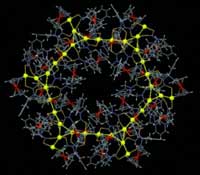May 15 2008
Chinese researchers have recently made a “golden crown” with a diameter of only a few nanometers. It is a large ring-shaped molecule containing 36 gold atoms. The lords of the ring, a team of researchers from the Universities of Beijing, Hong Kong, and Nanjing report their unusual compound in the journal Angewandte Chemie: the molecular ring structure is held together exclusively by gold–gold bonds and is thus the largest ring system made of gold atoms produced to date.
 A giant, crown-like Au36 ring aggregate with continuous metal-metal contacts (see picture; gold(I) centers are in ball and stick representation) is formed by an Au(I)-Au(I) bonding interaction directed self-assembly. Credit: (C) Wiley-VCH 2008
A giant, crown-like Au36 ring aggregate with continuous metal-metal contacts (see picture; gold(I) centers are in ball and stick representation) is formed by an Au(I)-Au(I) bonding interaction directed self-assembly. Credit: (C) Wiley-VCH 2008
Large molecular rings have fascinated chemists for over 40 years—ever since the discovery of crown ethers in 1967. The pioneers in this area, C. J. Pederson, J.-M. Lehn, and D. J. Cram received the Nobel Prize in Chemistry for their discovery in 1987. In the meantime, large molecular ring systems have played an important role in the search for new functional materials and in nanotechnology. The synthesis of ring systems held together exclusively by metal–metal bonds has remained a challenge.
Small rings made of positively charged gold atoms have been know for some time, but only recently could the Chinese team make a ring containing 16 gold atoms. Now, the researchers, led by Shu-Yan Yu, Yi-Zhi Li, and Vivian Wing-Wah Yam, have introduced a new representative of this class of compounds, the biggest gold ring to date that is held together by means of gold–gold bonds: a ring system containing 36 univalent gold atoms.
The researchers started their synthesis with a ring system containing six gold atoms. Three of the gold atoms are linked into a triangle. Each of these gold atoms is attached to another gold atom that sticks out from the corner of the triangle. Three organic ligands are then bound to this flat double triangle to form a molecule that resembles a three-blade propeller.
Six such “propellers” can be linked into a larger ring by means of a self-assembly process. Within this ring system, the gold atoms are arranged into a shape that resembles a crown: six double triangles are each bound to each other by two corners. The free double-corners point outward in a pattern that alternates above and below the plane of the ring. The paper can be seen here.